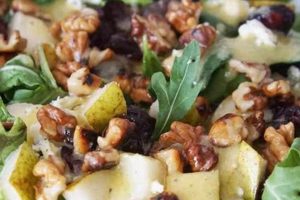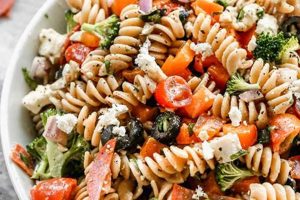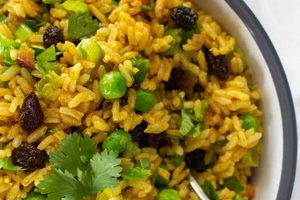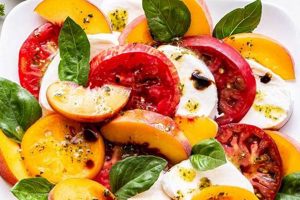Summer cookouts and warm-weather meals often feature grilled dishes. Integrating fresh, vibrant salads alongside these barbecued foods offers a balanced and flavorful dining experience. For example, a grilled corn and black bean salad with a lime vinaigrette complements smoky meats, while a watermelon and feta salad with mint provides a refreshing counterpoint to richer flavors. These dishes can range from simple green salads with grilled vegetable toppings to more complex composed salads featuring grilled proteins.
Balancing rich, savory barbecued foods with lighter, healthier options is crucial for a well-rounded meal. Salads provide essential vitamins, minerals, and fiber, contrasting the often heavier barbecue fare. Historically, salads have evolved from simple preparations of raw greens to intricate combinations incorporating various ingredients. This culinary evolution has led to the modern integration of salads into diverse cuisines, including barbecue traditions. The refreshing qualities of salads make them a particularly appealing accompaniment to grilled dishes, especially in warmer weather.
Exploring this culinary intersection reveals a wide array of flavor combinations and creative possibilities. From ingredient selection and preparation techniques to dressing choices and presentation, numerous factors contribute to a successful barbecue salad. Understanding these elements allows for a more informed approach to crafting complementary dishes that enhance the overall barbecue experience.
Tips for Enhancing Barbecued Meals with Salads
Strategic planning elevates the pairing of salads and barbecued dishes. Careful consideration of ingredients, flavors, and textures ensures a harmonious and satisfying meal.
Tip 1: Embrace Seasonal Produce: Selecting fruits and vegetables at their peak ripeness guarantees optimal flavor and nutritional value. Summer salads might include ripe tomatoes, cucumbers, and berries, while autumnal options could feature roasted squash, apples, and pomegranate seeds.
Tip 2: Grill Salad Components: Grilling certain vegetables before adding them to a salad imparts a smoky char and enhances their natural sweetness. Grilled corn, romaine hearts, or bell peppers add depth and complexity to the overall flavor profile.
Tip 3: Balance Flavors and Textures: Consider the richness of the barbecued dishes when selecting salad ingredients. A light and tangy vinaigrette can cut through the richness of smoked meats, while crunchy nuts or seeds offer textural contrast to tender greens.
Tip 4: Consider the Protein: Grilled chicken, fish, or tofu can be incorporated into salads for a complete and satisfying meal. These proteins absorb the smoky flavors of the grill, further complementing the barbecue theme.
Tip 5: Prepare Components in Advance: Washing, chopping, and grilling vegetables ahead of time streamlines the salad assembly process, allowing for a more relaxed dining experience.
Tip 6: Dress Strategically: Avoid overdressing the salad, as this can make it soggy, especially if served alongside saucy barbecue dishes. A light drizzle is often sufficient, and dressing can be served on the side for individual adjustment.
Tip 7: Elevate Presentation: Thoughtful plating enhances the visual appeal of the meal. Consider using a variety of colors and textures in the salad and arranging it attractively on the serving platter.
Prioritizing fresh, seasonal ingredients, incorporating grilled elements, and balancing flavors and textures contribute to creating salads that complement barbecued dishes, enhancing the overall dining experience.
By understanding these principles, one can elevate outdoor cooking beyond simply grilling meat, creating a cohesive and flavorful menu that caters to a variety of tastes and preferences.
1. Grilled Ingredients
Grilled ingredients contribute significantly to the distinctive character of barbecue salads. The process of grilling imparts a smoky char and caramelization, deepening the flavor profile of vegetables and fruits. This enhances their natural sweetness and adds complexity, creating a compelling contrast to the fresh, raw components of the salad. For instance, grilling romaine lettuce halves before chopping creates a smoky base for a Caesar salad variation, while grilled peaches offer a caramelized sweetness that complements savory cheeses like feta or goat cheese in a summer salad.
The choice of grilled ingredients influences the overall composition and balance of the salad. Heartier vegetables like zucchini, bell peppers, and onions hold their shape well on the grill and provide a substantial textural element. More delicate fruits, such as pineapple or watermelon, benefit from shorter grilling times to achieve a subtle char without becoming mushy. Grilling proteins like chicken or shrimp adds a smoky dimension to the salad while simultaneously serving as a central component of the meal. Understanding the interplay between these elements allows for the creation of balanced and flavorful compositions. Grilling corn on the cob before removing the kernels for a salad adds a sweet and smoky dimension that complements other ingredients like black beans, avocado, and a lime vinaigrette. Similarly, grilling slices of halloumi cheese before adding them to a salad with watermelon and mint creates a salty and savory counterpoint to the refreshing fruit. These examples highlight the transformative effect of grilling on common salad ingredients.
Integrating grilled components into salads elevates the barbecue dining experience. The smoky flavors enhance the overall complexity of the meal, offering a compelling counterpoint to traditional barbecue sides. The versatility of grilling allows for a wide range of ingredient combinations and flavor profiles, enabling customization to complement specific barbecue dishes and personal preferences. Mastering the art of grilling ingredients for salads expands culinary possibilities and provides a pathway to creating unique and satisfying barbecue meals. The practical application of this understanding lies in the ability to construct salads that not only complement the main barbecue dishes but also stand on their own as flavorful and visually appealing components of the meal.
2. Fresh Produce
Fresh produce forms the foundation of successful salad BBQ recipes. Its quality directly impacts the flavor, texture, and nutritional value of the final dish. Selecting and incorporating high-quality, seasonal produce elevates these salads from simple side dishes to vibrant, flavorful complements to grilled main courses. The inherent freshness offers a welcome counterpoint to the richness of barbecued meats, creating a balanced and satisfying meal.
- Seasonality
Prioritizing seasonal ingredients ensures optimal flavor and nutritional content. Summer salads benefit from the sweetness of ripe tomatoes, cucumbers, and berries, while autumnal options showcase the earthy flavors of roasted squash, apples, and pomegranates. Aligning salad components with seasonal availability guarantees the freshest and most flavorful produce, enhancing the overall dining experience.
- Variety and Color
Incorporating a variety of colors not only enhances visual appeal but also contributes to a broader spectrum of nutrients. A salad featuring a mix of greens, red bell peppers, orange carrots, and purple cabbage offers a wider range of vitamins and antioxidants than a monochromatic salad. This diversity of color and nutrients contributes to both the aesthetic and health benefits of the meal.
- Flavor Combinations
Fresh produce offers a diverse palette of flavors that can be strategically combined to create compelling salads. The sweetness of ripe melons complements the saltiness of feta cheese and the peppery bite of arugula. The acidity of citrus fruits balances the richness of grilled proteins and creamy dressings. Understanding these flavor interactions allows for the creation of complex and well-balanced salads.
- Preparation and Handling
Proper handling and preparation techniques are essential for preserving the quality and safety of fresh produce. Washing produce thoroughly removes dirt and potential contaminants, while careful storage maintains freshness. Techniques like blanching or quick-pickling can enhance the texture and flavor of certain vegetables, further contributing to the overall quality of the salad.
By emphasizing the use of fresh, seasonal produce, salad BBQ recipes become a vibrant and essential component of the outdoor cooking experience. The interplay of flavors, textures, and colors elevates these salads beyond simple accompaniments, transforming them into integral parts of a well-rounded and satisfying barbecue meal. The careful selection and preparation of fresh ingredients ultimately contribute to a more enjoyable and healthful dining experience.
3. Complementary Flavors
Complementary flavors are essential for successful salad BBQ recipes. The inherent richness and smokiness of barbecued foods necessitate thoughtful consideration of contrasting and balancing flavors within the accompanying salad. A successful pairing elevates both the salad and the main dish, creating a harmonious and satisfying meal. Acidity plays a crucial role; a vinaigrette with lemon or lime juice cuts through the richness of grilled meats, while the sweetness of grilled peaches or corn balances the savory notes of smoked chicken. The interplay of these flavors creates a dynamic and enjoyable culinary experience.
Understanding the principles of flavor pairing allows for strategic ingredient selection. Bitter greens, like arugula or radicchio, provide a refreshing counterpoint to the fattiness of barbecued ribs. Salty cheeses, such as feta or halloumi, complement the sweetness of grilled fruits and vegetables. The strategic use of herbs and spices further enhances flavor complexity; mint and cilantro add brightness, while chili flakes introduce a touch of heat. A grilled corn and black bean salad with a lime vinaigrette exemplifies this principle; the sweetness of the corn, the earthiness of the beans, and the tanginess of the lime create a balanced and flavorful salad that complements the smoky notes of barbecued meats. Similarly, a watermelon and feta salad with mint and a light balsamic glaze offers a refreshing contrast to richer barbecue fare.
Mastery of complementary flavors enhances the overall barbecue dining experience. A well-composed salad not only serves as a refreshing counterpoint to heavier dishes but also adds depth and complexity to the meal. Thoughtful flavor pairings elevate the individual components while creating a cohesive and satisfying culinary narrative. The ability to balance and contrast flavors is essential for crafting salad BBQ recipes that enhance the enjoyment of outdoor cooking and dining. This understanding allows for informed ingredient selection and recipe development, ultimately contributing to a more rewarding and memorable barbecue experience. The strategic use of complementary flavors transforms a simple salad into an integral component of a well-rounded barbecue meal, demonstrating the power of flavor pairings in elevating outdoor cuisine.
4. Textural Variety
Textural variety is a crucial element in crafting compelling salad BBQ recipes. A successful salad engages the palate with a combination of textures, creating a more dynamic and satisfying dining experience. This principle is particularly important when pairing salads with barbecued foods, which often feature rich, tender textures. Incorporating contrasting textures within the salad provides a welcome counterpoint, preventing the meal from becoming monotonous. Crisp, crunchy elements, such as toasted nuts, seeds, or raw vegetables, offer a textural contrast to the soft textures of grilled proteins and leafy greens. The interplay of these textures enhances the overall enjoyment of the meal, creating a more engaging and satisfying culinary experience. For example, a salad featuring grilled chicken, creamy avocado, crunchy toasted pecans, and crisp romaine lettuce offers a diverse textural profile that complements the tender texture of barbecued ribs. Similarly, a salad combining grilled halloumi, juicy watermelon, and peppery arugula provides a compelling interplay of textures that enhances the overall barbecue experience.
The strategic incorporation of textural variety elevates salad BBQ recipes beyond simple side dishes. Consider the difference between a basic garden salad and one that includes toasted croutons, candied pecans, or crispy fried onions. The addition of these elements transforms the salad, adding layers of complexity and interest. This principle extends to the use of grilled ingredients; grilling vegetables like corn or zucchini imparts a slight char and alters their texture, creating a more dynamic element within the salad. The choice of dressing also contributes to the overall textural experience; a creamy dressing offers a contrasting texture to crisp greens, while a light vinaigrette allows the individual textures of the salad components to shine. Understanding the interplay of these elements allows for the creation of salads that are not only flavorful but also texturally engaging.
Achieving textural variety in salad BBQ recipes demonstrates culinary expertise and enhances the enjoyment of the meal. It signifies an understanding of how different textures interact to create a balanced and satisfying sensory experience. This attention to detail elevates the perceived value of the salad, transforming it from a simple accompaniment to a key component of the barbecue experience. Mastering this principle allows for the creation of salads that complement barbecued foods in a sophisticated and nuanced way, demonstrating a comprehensive understanding of flavor and texture pairings. The ability to create texturally diverse salads enhances the overall appeal of barbecue cuisine, contributing to a more memorable and satisfying dining experience.
5. Balanced Dressings
Balanced dressings play a pivotal role in successful salad BBQ recipes. The inherent richness and smokiness of barbecued foods often require a counterpoint in the accompanying salad. Dressings provide this balance through acidity, sweetness, and other complementary flavors. Overly rich or heavy dressings can detract from the overall meal, overpowering the delicate flavors of fresh produce and clashing with the boldness of the barbecue. A balanced dressing, conversely, enhances the salad’s components while also complementing the main course. For instance, a light vinaigrette with lemon juice, Dijon mustard, and fresh herbs provides a refreshing acidity that cuts through the richness of smoked meats, while a honey-lime dressing offers a sweet and tangy counterpoint to grilled chicken or fish. Understanding the interplay between the dressing and other salad components, as well as the main dish, is essential for creating a harmonious and satisfying meal.
The choice of dressing significantly impacts the overall flavor profile and textural experience of the salad. A creamy dressing, while delicious, may not be the ideal choice for a salad served alongside saucy barbecued ribs. A lighter vinaigrette, on the other hand, offers a refreshing contrast and prevents the meal from becoming overly heavy. Similarly, a sweet and fruity dressing may clash with the savory notes of smoked brisket, while a tangy dressing with herbs and spices complements the smoky flavors. Practical application of this understanding involves considering the specific barbecue dishes being served and selecting a dressing that complements, rather than competes with, their flavors. A grilled corn and avocado salad, for example, benefits from a bright cilantro-lime dressing, while a salad featuring grilled peaches and halloumi pairs well with a light honey-balsamic vinaigrette. These examples demonstrate the importance of tailoring the dressing to the specific ingredients and overall flavor profile of the meal.
Achieving balance in salad dressings for barbecue meals requires careful consideration of flavor profiles, textures, and the overall composition of the meal. A well-balanced dressing not only enhances the flavors of the salad itself but also complements the main barbecue dishes, creating a cohesive and satisfying dining experience. Failure to consider these factors can result in a salad that clashes with the other elements of the meal, detracting from the overall enjoyment. By understanding the principles of balance and applying them to dressing selection, one can elevate salad BBQ recipes from simple accompaniments to integral components of a well-rounded and flavorful barbecue experience. This knowledge empowers individuals to create salads that not only provide a refreshing counterpoint to rich barbecued foods but also contribute to a more nuanced and satisfying culinary experience. The strategic use of balanced dressings exemplifies culinary expertise and enhances the enjoyment of outdoor cooking and dining.
6. Creative Presentation
Creative presentation elevates salad BBQ recipes from simple side dishes to visually appealing components of a complete meal. Thoughtful plating enhances the perceived value and enjoyment of these salads, transforming them into integral parts of the barbecue experience. Visual appeal stimulates appetite and enhances the overall dining experience, demonstrating an attention to detail that elevates outdoor cooking. The following facets illustrate how creative presentation enhances salad BBQ recipes.
- Plating Techniques
Utilizing various plating techniques transforms a basic salad into a visually engaging dish. Instead of simply tossing ingredients together, consider layering them for a more dynamic presentation. For example, a grilled romaine salad can be plated by arranging the halved romaine hearts on a platter, topping them with other grilled vegetables, and finishing with a sprinkle of feta cheese and a drizzle of vinaigrette. This layered approach creates visual interest and showcases the individual components of the salad. Other techniques, such as using a ring mold to create a composed salad or arranging ingredients in a visually appealing pattern, further enhance the presentation.
- Color and Contrast
Color plays a crucial role in food presentation. Vibrant, contrasting colors create a visually appealing salad that stimulates the appetite. A salad featuring a mix of dark leafy greens, bright red tomatoes, orange bell peppers, and yellow corn offers a more engaging visual experience than a monochromatic salad. Consider the color wheel when selecting ingredients, aiming for a variety of hues that complement each other. Grilling certain vegetables, like bell peppers or zucchini, can also enhance their color and add visual interest.
- Garnishes and Finishing Touches
Garnishes and finishing touches add a final layer of sophistication to salad presentation. A sprinkle of fresh herbs, a drizzle of balsamic glaze, or a scattering of toasted nuts or seeds elevates the visual appeal and adds a burst of flavor. These small details demonstrate attention to detail and enhance the overall dining experience. For a grilled peach and halloumi salad, a sprinkle of chopped mint and a drizzle of honey add visual appeal and complement the flavors of the dish. Similarly, a grilled corn and black bean salad can be garnished with crumbled cotija cheese and chopped cilantro for added flavor and visual interest.
- Serving Vessels
The choice of serving vessel contributes to the overall presentation of the salad. A rustic wooden bowl complements the casual atmosphere of a barbecue, while a sleek ceramic platter adds a touch of elegance. Consider the overall theme and style of the barbecue when selecting serving vessels. Individual portions can be served in small bowls or jars for a more personalized touch. Using unique or unexpected serving vessels, such as hollowed-out fruits or vegetables, can further enhance the presentation and create a memorable dining experience.
By focusing on creative presentation, salad BBQ recipes become more than just side dishes; they become integral components of a well-rounded and visually appealing barbecue meal. These techniques demonstrate culinary expertise and enhance the overall enjoyment of the dining experience. Attention to detail in presentation elevates the perceived value of the salad, transforming it from a simple accompaniment to a key element of the barbecue experience. This consideration ultimately contributes to a more memorable and satisfying outdoor dining experience.
7. Seasonal Adaptations
Seasonal adaptations are crucial for maximizing flavor and freshness in salad BBQ recipes. Aligning ingredients with their peak availability ensures optimal taste and nutritional value, reflecting a commitment to quality and culinary expertise. This adaptability also allows for continuous creativity, keeping menus fresh and exciting throughout the year.
- Spring Salads
Spring offers delicate flavors and vibrant greens. Asparagus, peas, and fresh herbs like mint and chives create bright, refreshing salads. A lemon-herb vinaigrette complements these flavors, providing a light and zesty counterpoint to grilled fish or chicken. These salads embody the essence of renewal and fresh starts associated with spring.
- Summer Salads
Summer’s abundance of ripe produce allows for bold and flavorful salads. Tomatoes, cucumbers, watermelon, and berries provide sweetness and juiciness. Grilled corn and peaches add smoky sweetness. Feta cheese, herbs like basil and oregano, and light vinaigrettes create balanced and refreshing salads that complement grilled meats and seafood.
- Autumn Salads
Autumn brings earthy flavors and hearty textures. Roasted root vegetables like sweet potatoes and butternut squash, combined with apples, pears, and cranberries, create robust salads. Toasted nuts, seeds, and crumbled cheeses like goat cheese or blue cheese add richness and complexity. Maple-balsamic vinaigrettes complement these autumnal flavors.
- Winter Salads
Winter salads focus on heartier ingredients and robust flavors. Kale, Brussels sprouts, and citrus fruits provide nutritional value and vibrant color. Roasted vegetables, dried fruits, and nuts add warmth and substance. Citrus vinaigrettes or creamy dressings with tahini or yogurt provide richness and balance, complementing grilled winter vegetables or roasted meats.
Adapting salad BBQ recipes to seasonal produce showcases culinary creativity and a commitment to fresh, flavorful ingredients. This approach ensures that salads remain a vibrant and exciting component of the barbecue experience throughout the year, reflecting the inherent diversity and abundance of each season. By embracing seasonal adaptations, one elevates barbecue cuisine beyond the ordinary, demonstrating a nuanced understanding of flavor pairings and a dedication to culinary excellence.
Frequently Asked Questions
This section addresses common inquiries regarding the integration of salads into barbecue meals, offering practical guidance and clarifying potential misconceptions.
Question 1: Can leafy greens withstand the heat of grilling?
Heartier greens like romaine or radicchio can be grilled, adding a smoky dimension. Delicate greens like spinach or butter lettuce are better suited for raw applications.
Question 2: What dressings are best suited for barbecue salads?
Vinaigrettes with citrus or vinegar offer a refreshing counterpoint to rich barbecue flavors. Creamy dressings can be suitable depending on the other salad components and the main dish.
Question 3: How can salads be kept fresh during outdoor dining?
Prepare components in advance and store them separately. Dress salads just before serving or offer dressing on the side to prevent wilting.
Question 4: Can grilled fruit be incorporated into savory salads?
Grilled fruits like peaches, pineapple, or watermelon add a nuanced sweetness that complements savory cheeses and grilled proteins.
Question 5: What are suitable protein options for barbecue salads?
Grilled chicken, fish, shrimp, or tofu complement barbecue flavors. Beans, lentils, or nuts offer plant-based protein options.
Question 6: How can one ensure balanced nutrition in a barbecue meal with salads?
Incorporating a variety of colorful vegetables, lean proteins, and healthy fats ensures a balanced and nutritious meal.
Understanding these considerations allows for informed choices regarding ingredient selection, preparation, and presentation, optimizing the enjoyment and nutritional value of barbecue salads.
Beyond these frequently asked questions, further exploration of specific salad BBQ recipes offers detailed guidance for creating delicious and visually appealing dishes that enhance any barbecue experience.
Elevating the Barbecue Experience
Strategic integration of salads within barbecue cuisine offers a compelling approach to balancing rich, smoky flavors with fresh, vibrant ingredients. Careful consideration of complementary flavors, textural variety, balanced dressings, and creative presentation transforms these salads from simple accompaniments to integral components of the meal. Seasonal adaptations further enhance the versatility and appeal of barbecue salads, ensuring optimal flavor and freshness throughout the year. From grilled romaine with smoky char to vibrant summer salads bursting with ripe produce, the possibilities are diverse and adaptable to individual preferences and dietary needs. The exploration of these elements underscores the potential of salads to elevate barbecue cuisine beyond traditional expectations.
Culinary innovation within the barbecue landscape continues to evolve. The intersection of fresh, vibrant salads and the bold flavors of barbecue presents an opportunity to redefine outdoor cooking. By embracing the principles outlined herein, individuals can elevate their barbecue experiences, creating meals that are not only flavorful and satisfying but also visually appealing and nutritionally balanced. This approach fosters a deeper appreciation for the culinary arts and encourages a more thoughtful and creative approach to outdoor cooking. The ongoing exploration of flavor profiles, ingredient combinations, and presentation techniques promises a future rich with innovative and exciting barbecue salad creations.






